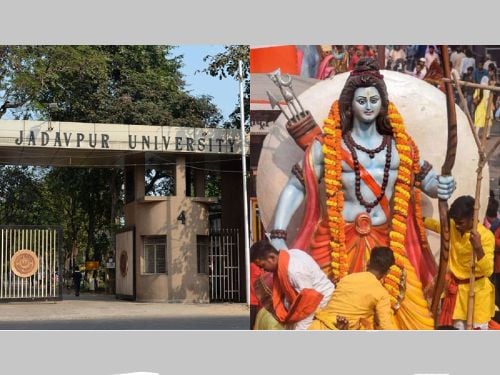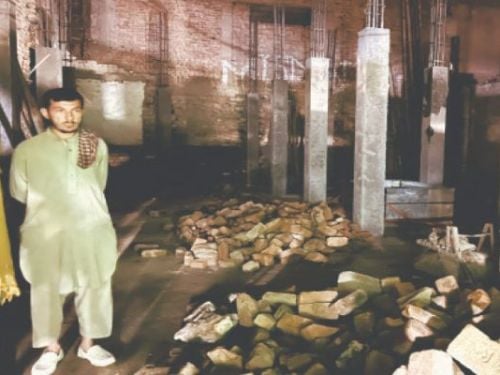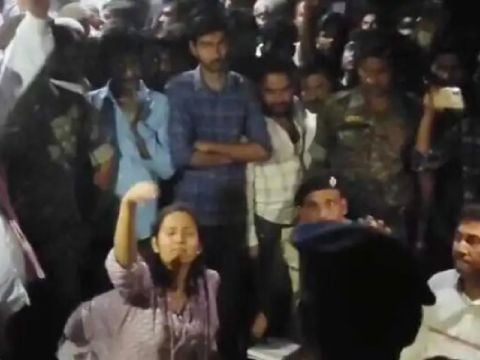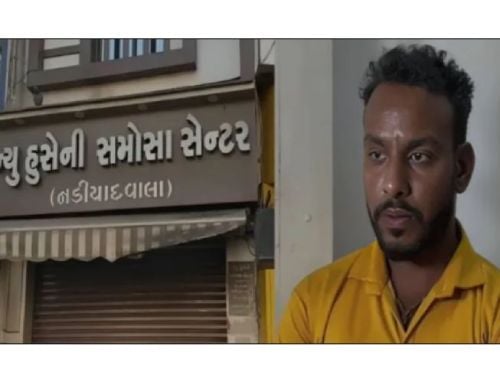
A suit has been filed before the court of civil Senior Divisional Judge, Varanasi on Thursday seeking restoration of the permanence of worship rituals at the principal seat of an ancient temple which is now part of the Gyanvapi mosque complex near the Kashi Vishwanath temple. The suit has been filed by Rajana Agnihotri and 9 other devotees who are also worshippers of Lord Shiva practising the Vedic Sanatan Hindu Dharma.
The suit has been registered as a miscellaneous case that will come up before the concerned court for the hearing, as informed by petitioners’ counsel HS Jain. Counsel for the Committee of Management Anjuman Intazamia Masajid, who was reportedly present in the court from the respondents’ side, sought time for filing a counter affidavit. The other respondents in the case are the Union of India through the Ministry of Home Affairs, the State of Uttar Pradesh, District Magistrate of Varanasi, Superintendent of Police, Varanasi, UP Sunni Central Waqf Board and the Board of Trustees Kashi Vishwanath temple.
Petition seeks to declare the devotees entitled to darshan and pooja at the disputed area
The petition primarily seeks to declare the devotees of Goddess Gauri, Lord Hanuman, Lord Ganesh Ji, Nandi Ji and Lord Visheshwar as entitled to have darshan, pooja and worship rituals within the area of dispute. The petition states that Article 25 of the Constitution confers on every citizen a fundamental right to worship and rituals according to the tenets of his or her religion. It further states that any obstacle created before 26th January, 1950 has become null and void by virtue of Article 13(1). “An idol worshipper cannot complete his pooja and gain spiritual advantages without having objects of worship. Any hindrance/obstacle created in performance of pooja, is denial of right to religion guaranteed under Article 25 of the Constitution of India”, the petition reads.
Aurangzeb had ordered desecration of the Kashi temple in 1669 : Petition
The petition states that the Jyotirlinga was desecrated and damaged on the orders Mughal ruler Aurangzeb, whom the petition terms as ‘one of the most cruel rulers of India’, in the year 1669. However, other deities including Goddess Maa Shringar Gauri within the temple complex which is claimed to be part of the Gyanvapi mosque by the Muslim community. “That Aurangzeb, one of the cruelest Islamic rulers, was the champion in destruction of Hindu temples. He had issues Farmaans in the year 1669 to destroy many temples including the Kashi and Mathura which were prominently worshipped by Hindus. The administration complied with the order and demolished a portion of temple of Adi Visheshwar at Varanasi and later on a construction was raised which they alleged Gyanvapi mosque but they could not change the religious character of the Hindu temple as the idol of Goddess Shringar Gauri, Lord Ganesha and other associate deities continued in the same building”, the petition claimed.
Ownership of the disputed area lies with Lord Visheshwar : Petition
It is contended in the petition that the ownership of the entire property within the radius of five kos vests in Asthan Adi Visheshwar. It further argues that forcible possession of the religious place cannot alter the nature of the property and the ownership rights of the existing deity. “It is historically proved that in 1585, Raja Todar Mal, the Finance Minister of Akbar, who was the Governor of Jaunpur, had re-established and reconstructed a magnificent Lord Shiva temple at its original place consisting of a sanctum sanctorum (Garch Griha) surrounded by eight Mandapas and pavilions, which is known as the old temple”, the petition states. The plea cites Puranic ordains to say that the worship of Goddess Gauri is necessary to achieve the complete fruits of worship of Lord Vishwanath.
It has been contended in the petition that the devotees had been offering daily pooja at the disputed place until the place was restricted in 1990 by the Uttar Pradesh government to ‘appease the Muslims’ during the Ayodhya movement.
The property was never given to Waqf after demolition of temple: Petition
Rejection the claim that the property belonged to the Waqf Board, the petition said that neither the Historical books written during the Mughal period nor any Muslim historians have ever claimed that any Waqf was created by Aurangzeb by demolishing the Adi Visheshwar temple or that any member of the Muslim community or any other ruler gave the property to Waqf. The petition challenges section 4 of the Places of Worship Act as ultra vires and void, arguing that the Parliament is not empowered to enact a law that takes away or abridges the right conferred by Article 25 of the Constitution.
“This place is sacred for Hindus from the time immemorial. The temple existing thereat was demolished by Muslim invaders. It is submitted that Hindus cannot be compelled to suffer mental and spiritual shock continuously and the same is bound to affect the worldly and spiritual life of the masses for swallowing the tyrannical, wicked and cruel acts of invaders”, the plea submits.
Reliefs sought in the petition
The plea seeks the following reliefs:
- A decree declaring that the devotees are entitled to darshan, pooja and worship of devotees within the area.
- Declaration that the entire disputed area belongs to the Lord Adi Visheshwar situated at Dashashwamedh at the heard of Varanasi.
- A decree in the nature of perpetual injunction against the defendants prohibiting them, their workers, agents, officials, officers and every person acting under them from interfering with or raising any objection or obstruction in the construction of a new temple building after demolishing and removing the existing structures situated thereat.
- A decree restoring pooja and worship of Goddess Gauri, Goddess Maa Ganga, Lord Hanuman, Lord Ganeshji, Nandji and Lord Adi Visheshwar making appropriate arrangement for darshan and pooja by devotees maintaining law and order.
Source : OpIndia

 Jadavpur Univ revokes permission to celebrate Ram Navami on campus after granting it
Jadavpur Univ revokes permission to celebrate Ram Navami on campus after granting it Andhra Pradesh: Farooq kills mentally challenged Hindu man for insurance money
Andhra Pradesh: Farooq kills mentally challenged Hindu man for insurance money Pakistan: Ancient Hindu temple in Khyber Pakhtunkhwa demolished for commercial complex
Pakistan: Ancient Hindu temple in Khyber Pakhtunkhwa demolished for commercial complex Bihar: Goddess Bhagavati Temple in Araria vandalised and deities damaged
Bihar: Goddess Bhagavati Temple in Araria vandalised and deities damaged Vadodara: Beef supplier Imran Qureshi arrested in beef-stuffed samosa case
Vadodara: Beef supplier Imran Qureshi arrested in beef-stuffed samosa case After Idukki diocese, Syro Malabar Catholic Church’s Thamarassery diocese screens ‘The Kerala Story’
After Idukki diocese, Syro Malabar Catholic Church’s Thamarassery diocese screens ‘The Kerala Story’